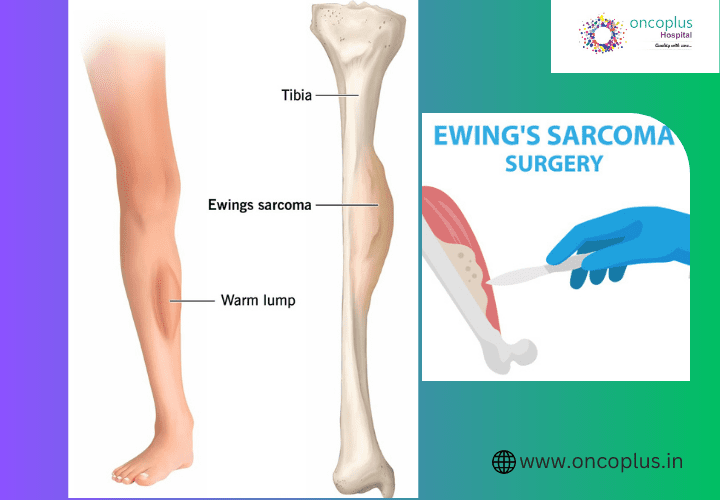ETV6 Protein Could Be an Important Target for Ewing Sarcoma Treatment

ETV6 Protein Could Be an Important Target for Ewing Sarcoma Treatment
- onco
- June 20, 2023
Ewing sarcoma is a rare, aggressive form of bone cancer primarily affecting children and young adults. The disease is named after Dr James Ewing, who first described it in 1921. While chemotherapy and radiation therapy can be effective in treating Ewing sarcoma, many patients experience relapse or resistance to these treatments, highlighting the need for new therapeutic targets. Recent research has identified the ETV6 protein as a potential target for Ewing sarcoma treatment. In this blog, we will discuss about Ewing sarcoma, its symptoms, treatments and how ETV6 protein can be an essential target for Ewing sarcoma treatment in Delhi, India.
What is Ewing Sarcoma?
Ewing Sarcoma is most commonly found in children and young adults and is often diagnosed in people between the ages of 10 and 20. Children and teenagers are more likely to develop the rare bone and soft tissue cancer known as Ewing sarcoma, sometimes referred to as Ewing’s sarcoma and Ewing tumour. When the DNA in some cells alters, aberrant cells that attack healthy tissue are created, leading to Ewing sarcoma. More information about the relationship between cell alterations and Ewing sarcoma is being discovered. New Ewing sarcoma treatments are being tested in clinical trials because of this research, and these trials may be beneficial for young patients with Ewing sarcoma.
Symptoms of Ewing Sarcoma:
Symptoms of Ewing Sarcoma can vary depending on the location of the tumour but can include:
- Discomfort or inflammation in the affected area.
- Difficulty moving the affected limb.
- A noticeable lump or mass.
- Fever or fatigue.
- Unexplained weight loss.
- Bone fractures that occur without a significant injury.
- For a correct diagnosis, it’s crucial to consult a doctor as soon as you can if you or someone you know is exhibiting any of these symptoms.
Ewing Sarcoma Treatments:
Treatments for Ewing Sarcoma typically involve a combination of chemotherapy, radiation therapy, and surgery. The specific treatment plan will depend on the size and location of the tumor, as well as the stage of the cancer.
Chemotherapy is often the first line of treatment and involves the use of drugs to kill cancer cells. The tumour is reduced in size and any leftover cancer cells are eradicated with radiation therapy. Surgery may be necessary to remove the tumor or affected bone, and can be followed by reconstructive surgery if necessary. In some cases, a stem cell transplant may be recommended after chemotherapy or radiation therapy to help restore the body’s blood cells and immune system.
Overall, early detection and prompt treatment are crucial for improving outcomes for those with Ewing Sarcoma. If you have concerns or questions about Ewing Sarcoma or any other health condition, it is important to speak with a qualified healthcare provider.
What is ETV6 Protein?
ETV6 is a transcription factor, a protein that regulates the expression of other genes. It is involved in a variety of cellular processes, including cell proliferation, differentiation, and apoptosis. ETV6 has been implicated in several types of cancer, including leukemia, lymphoma, and solid tumors such as prostate cancer and breast cancer. However, its role in Ewing sarcoma has only recently been discovered.
In a study published in the journal Cancer Cell, researchers found that ETV6 is essential for the growth and survival of Ewing sarcoma cells. The researchers used CRISPR-Cas9 gene editing technology to disrupt the ETV6 gene in Ewing sarcoma cell lines. They found that when ETV6 was knocked out, the cells stopped proliferating and underwent apoptosis, a process of programmed cell death. These results suggest that targeting ETV6 could be an effective strategy for treating Ewing sarcoma.
The researchers also investigated the mechanism by which ETV6 promotes Ewing sarcoma growth. They found that ETV6 regulates the expression of genes involved in several key cellular processes, including cell cycle progression, DNA damage repair, and metabolism. By controlling these processes, ETV6 enables Ewing sarcoma cells to survive and proliferate in the hostile environment of the tumor microenvironment.
The researchers further demonstrated the therapeutic potential of targeting ETV6 in Ewing sarcoma by using a small molecule inhibitor called TK216. TK216 was designed to block the interaction between ETV6 and another protein called RNA polymerase II, which is involved in the transcription of DNA into RNA. The researchers found that TK216 inhibited the growth of Ewing sarcoma cells in vitro and in vivo, without affecting normal cells. Importantly, TK216 also showed synergy with standard chemotherapy drugs used to treat Ewing sarcoma, suggesting that it could be used in combination with these drugs to enhance their efficacy.
In conclusion, the discovery of ETV6 as a potential therapeutic target for Ewing sarcoma is a significant breakthrough in the field of cancer research. The findings of this study provide a foundation for the development of new drugs that target ETV6 and could improve treatment outcomes for Ewing sarcoma patients. The use of TK216, a small molecule inhibitor of ETV6, shows promise as a potential treatment for Ewing sarcoma and warrants further investigation. As more is learned about the role of ETV6 in Ewing sarcoma, it could also serve as a valuable biomarker for diagnosis and monitoring of this devastating disease. With advancements in medical technology and the availability of highly trained oncology surgeons in Delhi patients suffering from this rare form of cancer have access to world-class treatment options.
Recent Posts
-
Pap Smear Screening for Cervical Cancer: Everything You Need to Know
February 26, 2025





Leave a Reply